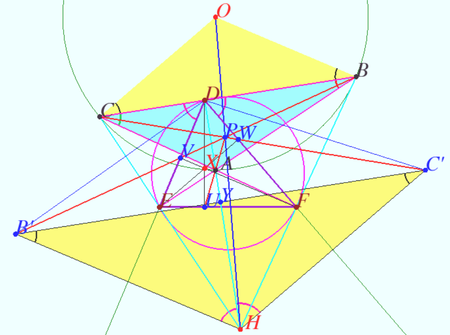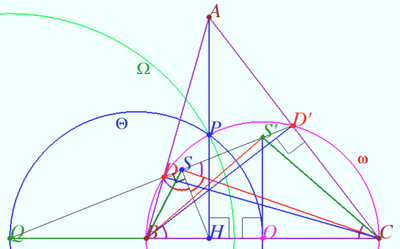Difference between revisions of "Kimberling’s point X(24)"
(→Kimberling's point X(24)) |
|||
| Line 6: | Line 6: | ||
<i><b>Theorem 1</b></i> | <i><b>Theorem 1</b></i> | ||
| − | Denote <math>T_0</math> obtuse or acute <math>\triangle ABC.</math> Let <math>T_0</math> be the base triangle, <math>T_1 = \triangle DEF</math> be Orthic triangle of <math>T_0, T_2 = \triangle UVW</math> be | + | Denote <math>T_0</math> obtuse or acute <math>\triangle ABC.</math> Let <math>T_0</math> be the base triangle, <math>T_1 = \triangle DEF</math> be Orthic triangle of <math>T_0, T_2 = \triangle UVW</math> be Orthic Triangle of <math>T_1</math>. Let <math>O</math> and <math>H</math> be the circumcenter and orthocenter of <math>T_0.</math> |
Then <math>\triangle T_0</math> and <math>\triangle T_2</math> are homothetic, the point <math>P,</math> center of this homothety lies on Euler line <math>OH</math> of <math>T_0.</math> | Then <math>\triangle T_0</math> and <math>\triangle T_2</math> are homothetic, the point <math>P,</math> center of this homothety lies on Euler line <math>OH</math> of <math>T_0.</math> | ||
| Line 15: | Line 15: | ||
WLOG, we use case <math>\angle A = \alpha > 90^\circ.</math> | WLOG, we use case <math>\angle A = \alpha > 90^\circ.</math> | ||
| − | |||
| − | In accordance with Claim, <math>\angle BVD = \angle HVE \implies B', V,</math> and <math>B</math> are collinear. | + | Let <math>B'</math> be reflection <math>H</math> in <math>DE.</math> In accordance with Claim, <math>\angle BVD = \angle HVE \implies B', V,</math> and <math>B</math> are collinear. |
Similarly, <math>C, W,</math> and <math>C',</math> were <math>C'</math> is reflection <math>H</math> in <math>DF,</math> are collinear. | Similarly, <math>C, W,</math> and <math>C',</math> were <math>C'</math> is reflection <math>H</math> in <math>DF,</math> are collinear. | ||
| Line 30: | Line 29: | ||
<math>\triangle HB'C' \sim \triangle OBC, BB', CC'</math> and <math>HO</math> are concurrent at point <math>P.</math> | <math>\triangle HB'C' \sim \triangle OBC, BB', CC'</math> and <math>HO</math> are concurrent at point <math>P.</math> | ||
| − | In accordance with Claim, <math>\angle HUF = \angle AUF \implies</math> points <math>H</math> and <math>P</math> are isogonal conjugate with respect <math>\triangle UVW.</math> | + | In accordance with <i><b>Claim,</b></i> <math>\angle HUF = \angle AUF \implies</math> points <math>H</math> and <math>P</math> are isogonal conjugate with respect <math>\triangle UVW.</math> |
| − | < | + | <cmath>\angle HDE = \alpha - 90^\circ, \angle HCD = 90^\circ - \beta \implies</cmath> |
| − | < | + | <cmath>HB' = 2 HD \sin (\alpha - 90^\circ) = - 2 CD \tan(90^\circ- \beta) \cos \alpha = - 2 AC \cos \gamma \frac {\cos \beta}{\sin \beta} \cos \alpha = - 4 OB \cos A \cos B \cos C.</cmath> |
| − | < | + | <cmath>k = \frac {HB'}{OB} = \frac {HP}{OP}= - 4 \cos A \cos B \cos C \implies \frac {\vec {PH}}{\vec {OP}}= 4 \cos A \cos B \cos C.</cmath> |
<i><b>Claim</b></i> | <i><b>Claim</b></i> | ||
| Line 52: | Line 51: | ||
Well known that <math>AH</math> is the polar of point <math>Q,</math> so <math>QO \cdot HO = QP^2 \implies QB \cdot QC = (QO – R) \cdot (QO + R) = QP^2</math> <cmath>\implies P \in \Theta, \Omega \perp \omega.</cmath> | Well known that <math>AH</math> is the polar of point <math>Q,</math> so <math>QO \cdot HO = QP^2 \implies QB \cdot QC = (QO – R) \cdot (QO + R) = QP^2</math> <cmath>\implies P \in \Theta, \Omega \perp \omega.</cmath> | ||
| − | Let <math>I_{\Omega}</math> be inversion with respect <math>\Omega, I_{\Omega}(B) = C, I_{\Omega}(H) = O.</math> | + | Let <math>I_{\Omega}</math> be inversion with respect <math>\Omega, I_{\Omega}(B) = C, I_{\Omega}(H) = O,I_{\Omega}(D) = D'.</math> |
| − | Denote <math> | + | Denote <math>I_{\Omega}(S) = S'.</math> |
<cmath>HS \perp DD' \implies S'O \perp BC \implies BS' = CS' \implies \angle OCS' = \angle OBS'.</cmath> | <cmath>HS \perp DD' \implies S'O \perp BC \implies BS' = CS' \implies \angle OCS' = \angle OBS'.</cmath> | ||
Revision as of 13:00, 12 October 2022
Kimberling's point X(24)
Kimberling defined point X(24) as perspector of ![]() and Orthic Triangle of the Orthic Triangle of
and Orthic Triangle of the Orthic Triangle of ![]() .
.
Theorem 1
Denote ![]() obtuse or acute
obtuse or acute ![]() Let
Let ![]() be the base triangle,
be the base triangle, ![]() be Orthic triangle of
be Orthic triangle of ![]() be Orthic Triangle of
be Orthic Triangle of ![]() . Let
. Let ![]() and
and ![]() be the circumcenter and orthocenter of
be the circumcenter and orthocenter of ![]()
Then ![]() and
and ![]() are homothetic, the point
are homothetic, the point ![]() center of this homothety lies on Euler line
center of this homothety lies on Euler line ![]() of
of ![]()
The ratio of the homothety is ![]()
Proof
WLOG, we use case ![]()
Let ![]() be reflection
be reflection ![]() in
in ![]() In accordance with Claim,
In accordance with Claim, ![]() and
and ![]() are collinear.
are collinear.
Similarly, ![]() and
and ![]() were
were ![]() is reflection
is reflection ![]() in
in ![]() are collinear.
are collinear.
Denote ![]()
![]()
![]()
![]()
![]() and
and ![]() are concurrent at point
are concurrent at point ![]()
In accordance with Claim, ![]() points
points ![]() and
and ![]() are isogonal conjugate with respect
are isogonal conjugate with respect ![]()
![]()
![]()
![]()
Claim
Let ![]() be an acute triangle, and let
be an acute triangle, and let ![]() and
and ![]() denote its altitudes. Lines
denote its altitudes. Lines ![]() and
and ![]() meet at
meet at ![]() Prove that
Prove that ![]()
Proof
Let ![]() be the circle
be the circle ![]() centered at
centered at ![]() is midpoint
is midpoint ![]()
Let ![]() meet
meet ![]() at
at ![]() Let
Let ![]() be the circle centered at
be the circle centered at ![]() with radius
with radius ![]()
Let ![]() be the circle with diameter
be the circle with diameter ![]()
Well known that ![]() is the polar of point
is the polar of point ![]() so
so ![]()
![]()
Let ![]() be inversion with respect
be inversion with respect ![]()
Denote ![]()
![]()
![]()
![]()
Theorem 2
Let ![]() be the base triangle,
be the base triangle, ![]() be orthic triangle of
be orthic triangle of ![]() be Kosnita triangle. Then
be Kosnita triangle. Then ![]() and
and ![]() are homothetic, the point
are homothetic, the point ![]() center of this homothety lies on Euler line of
center of this homothety lies on Euler line of ![]() the ratio of the homothety is
the ratio of the homothety is ![]() We recall that vertex of Kosnita triangle are:
We recall that vertex of Kosnita triangle are: ![]() is the circumcenter of
is the circumcenter of ![]() is the circumcenter of
is the circumcenter of ![]() is the circumcenter of
is the circumcenter of ![]() where
where ![]() is circumcenter of
is circumcenter of ![]()
vladimir.shelomovskii@gmail.com, vvsss











